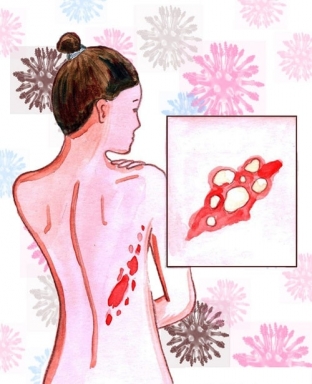Chickenpox transferred in childhood reminds us that now the herpes virus has settled in the body forever, which will be in a latent state and remind of itself at the most inopportune moments. Most often, such moments occur after serious illnesses or weakening of the body's defenses after operations, including plastic ones, as well as in the spring and autumn periods. Activation of the virus can cause herpes zoster, which brings considerable suffering to the patient and, with inadequate treatment, even causes severe complications.
Why and who develops herpes zoster
The herpes virus remains in a latent state, settling in the nerve ganglia, and therefore herpes zoster, when activated, is manifested primarily by swelling of the nerve trunks and their infringement. That is why the disease is very painful and brings great suffering to the patient. Most often, herpes zoster occurs in middle-aged people, women complain somewhat less often than men.
Against the backdrop of weakening the body's defenses, the virus infects the ganglia of some intervertebral and cranial nerves, branches of the trigeminal nerve, which causes severe pain and rashes, characteristically located along the nerves. The disease can be provoked by:
- infections,
- pneumonia,
- development of neoplasms, blood diseases,
- surgical interventions,
- significant overwork and stress,
- taking certain medications (eg, corticosteroids, cytostatics),
- seasonal beriberi.
In the elderly, a generalized form of herpes zoster can develop, when, against the background of severe intoxication and severe rashes, the lungs and membranes of the brain are affected, significantly worsening the prognosis of the disease.
How is herpes zoster manifested and what are its features
 The typical presentation of herpes zoster begins with severe pain in the area where the rash will later appear. A nerve affected by a virus can cause various pain sensations – from burning and paroxysmal to excruciating cutting. In parallel, a general malaise develops, a high temperature rises, the patient complains of severe chills. It should be noted that the general malaise – not a necessary symptom. After about five days, sometimes earlier, the skin over the affected nerve endings becomes edematous, inflamed, grouped bubbles with transparent contents appear on it. Their appearance helps confirm the diagnosis of herpes zoster, as they are localized along the inflamed nerves. Bubbles can also appear in the oral cavity, where they quickly open, merge in erosion, covered with bloom. On the skin, the bubbles gradually shrink and become covered with crusts, and in case of injury, they open and cause erosion.
The typical presentation of herpes zoster begins with severe pain in the area where the rash will later appear. A nerve affected by a virus can cause various pain sensations – from burning and paroxysmal to excruciating cutting. In parallel, a general malaise develops, a high temperature rises, the patient complains of severe chills. It should be noted that the general malaise – not a necessary symptom. After about five days, sometimes earlier, the skin over the affected nerve endings becomes edematous, inflamed, grouped bubbles with transparent contents appear on it. Their appearance helps confirm the diagnosis of herpes zoster, as they are localized along the inflamed nerves. Bubbles can also appear in the oral cavity, where they quickly open, merge in erosion, covered with bloom. On the skin, the bubbles gradually shrink and become covered with crusts, and in case of injury, they open and cause erosion.
The disease lasts for about three weeks, the erosions become epithelialized, the crusts fall off, and pigmentation of the skin remains at the site of the rash for some time. Usually, herpes zoster ends successfully, but in significantly weakened patients and in elderly patients, complications are likely to develop in the form of neuralgia and hyperesthesia, which persist for several months or even years.
Methods and objectives of the treatment of herpes zoster
The main task of the doctor when prescribing therapy for herpes zoster should be to relieve pain and prevent the development of postherpetic complications.
Recommended prescription of antiviral drugs – intramuscularly and locally, it is considered effective to prescribe deoxyribonuclease to reduce the risk of complications. From the first days of the disease, laser therapy gives a good effect; when the rash resolves, local keratoplastic agents (for example, sea buckthorn ointment) are used. To relieve pain, analgesics, novocaine blockades are prescribed, dehydration therapy with salicylates helps to eliminate edema.
It is very important to increase the patient's body defenses simultaneously with antiviral treatment, for which a course of vitamin therapy and the use of adaptogens are recommended.







Add a comment